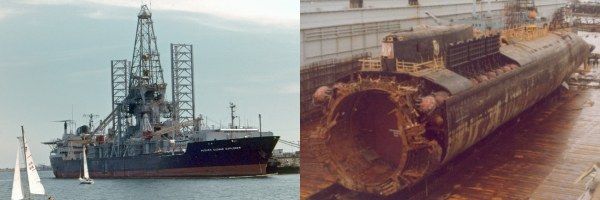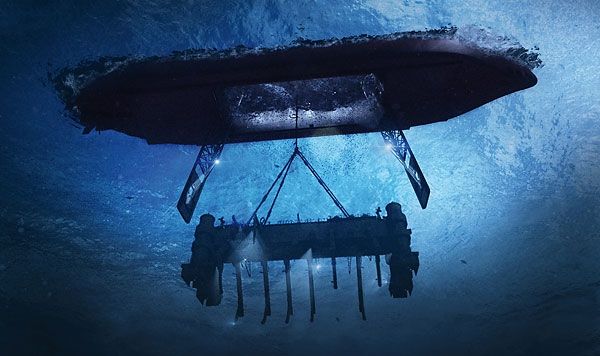This week in adaptation news, we saw a bit more progress on the Goosebumps feature film as Jack Black has joined the cast as an author haunted by his creations come to life. Hollywood beat Hollywood! Adapt This! to the punch on this one, but I'll be waiting to hear about an Are You Afraid of the Dark? adaptation in the meantime. Today's installment comes not from the pages of fiction or the television screens of yesteryear, but of the Cold War era and a CIA operation to covertly raise a sunken Soviet sub, the story of which was only relatively recently declassified. If you were a fan of Ben Affleck's Argo, you'll want to hit the jump for more. Hollywood! Adapt this: Project Azorian.
In March of 1968, the American SOSUS (sound surveillance system) detected what would turn out to be the implosion of Soviet nuclear submarine, K-129, a Golf II Class SSB strategic ballistic missile diesel submarine that housed three nuclear missiles and two nuclear torpedoes. American forces observed Soviet ships and planes performing unusual search operations a month or so later, but returned to their fleet once they were unsuccessful in that particular mission. Using their extensive sound detection network, the U.S. was able to narrow down the location of the downed sub to an area of 1,200 square miles. The USS Halibut was dispatched to the site in July of 1968 under Operation Sand Dollar, a mission to find and photograph the wreck, which they quickly achieved. Now that U.S. forces knew where the wreck was and had only a faint idea of the Soviet secrets it contained, the race was on to recover it. Here's where the story really starts.
Approved by President Richard Nixon, the CIA embarked on an extensive cover story for the global media while at the same time preparing a technical team, comprised of both personnel and heavy-duty equipment, in order to recover the wreck. Quite literally on the surface of things was the Hughes Glomar Explorer, a massive salvage ship built under the cover story of one Howard Hughes who said the mission for this particular ship was to mine manganese nodules from the ocean floor. Although Hughes' and his companies had no direct involvement in the ship's construction, his testimony did provide a reason for both the ship's existence and its eventual occupation of the wreck site.
The Hughes Glomar Explorer was a Trojan horse of sorts. Its hold housed a large metal claw - a capture vehicle affectionately nicknamed Clementine - which would descend to the sea floor, grab K-129 and retract to bring the submarine back within the belly of the ship. This would allow a covert recovery of K-129 that took place completely underwater and away from the prying eyes of the circling Soviet ships. Against all odds, the mission appeared to a success when the capture vehicle was nearing its return of K-129 to the Hughes Glomar Explorer's moon pool. Then, the device suffered a catastrophic failure and dropped two-thirds of the ship back to the sea floor. While technically an intelligence failure, the recovered third yielded two nuclear torpedoes, the bodies of six Russian servicemen and plenty of priceless intel.
How Could/Why Should It Be Adapted?
Project Azorian has been loosely adapted into numerous thriller novels, including William Wingate's Fireplay and James Follet's Ice; it may even have inspired the plot of James Cameron's 1989 film The Abyss. And yet, aside from the 2009 Michael White documentary, Azorian: The Raising of the K-129 (which I highly recommend checking out if you're interested), this dramatic story has yet to be given a feature treatment. While the events of the operation themselves are interesting enough to warrant the documentary, the atmosphere surrounding Project Azorian adds many layers to the story. Needless to say, relations between the U.S. and the Soviet Union were rather frosty; any discovery of this salvage operation could have led to another U-2 incident or Cuban Missile Crisis.
And it wasn't just the Russian spies and government officials the U.S. was trying to keep the story from, but domestic journalists and international media as well. The New York Times and the Los Angeles Times both ran stories in the mid-1970s that retold more of the government's attempts to stonewall the publications than of the events of Project Azorian itself. Oddly enough, the CIA then concluded that the Russians did not take any action once learning of the story. Any diplomatic tension was further smoothed out with the 1998 release of a 1974 video showing memorial services for the six Russian crewman, a video which the U.S. had shared with Russian dignitaries in the early 1990s. More details on Project Azorian were declassified in 2010, making it only a few short years since the big picture has been available to filmmakers to adapt.
Project Azorian has the aspects of the technical time-crunch of Ron Howard's Apollo 13 combined with the Cold War intrigue of Ben Affleck's Argo, and just like each of those successful films, it's based on the stranger-than-fiction true story. Like Argo's multi-tiered investment into characters involved with the operation, Project Azorian would be able to feature forces on both sides of the Cold War along with the technical search-and-recovery teams stuck in the middle and tasked with the construction and execution of the operation. Then, on the surface of things, show an aging Howard Hughes christening the Hughes Glomar Explorer with all the pomp and circumstance befitting a CIA cover story. Meanwhile, journalists on the homefront are attempting to root out the truth of the operation while government employees stonewall them under the party line of fear of causing an international incident. It's a project tailor-made for directors like Affleck, Howard and Cameron; they're not too busy these days, right?
Be sure to let us know your thoughts in the comments below and tune in next week when we tackle another lost property in Hollywood! Adapt This!


